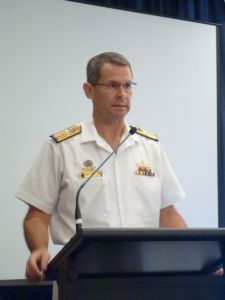
For the full listing of speakers at a symposium visit our Symposium history pages.
Quick Links - Speakers surnames in the range:
- H-I
 Alicia Aitken.
Alicia Aitken.
2022 Keynote: Scheduling: The Forgotten Art
Success with program delivery is never an accident. It relies on careful planning and scheduling to guide the team. The project controls equivalent of a lighthouse keeping the team from crashing on the rocks. Despite its importance many organisations have forgotten how critical their scheduling capability is to program success and have let it die off. This presentation will share a case study on how one organisation rediscovered the value of scheduling and regrew their capability.
2017: Project Management: Performance is mostly about people and culture.
This presentation takes you on her journey to the top of project management in Telstra, explaining why her role was created and what it does for her organisation. It outlines Telstra’s view on critical factors in delivering project success and how they are helping Telstra deliver better project outcomes. Download the Presentation.
 Dr. Chivonne Algeo.
Dr. Chivonne Algeo.
2016: Exploiting Project Knowledge to Enhance Project Governance and Control.
Managing intrinsic project knowledge has the potential to enhance project governance, and consequently the predictability of project outcomes. These control mechanisms can be mapped according to how knowledge is acquired and exchanged. Developing this map can minimise the potential for an overreliance on accidental opportunities to gather project intelligence, and deliver predictable project outcomes. However, an over-reliance on this systematic approach could drive mediocrity through conformity. Download the presentation.
 Glen Alleman
Glen Alleman
2023 Webinar: Capabilities-Based Planning and Defining and Delivering the Minimum Viable Capability in the Shortest Possible Time
A Capabilities-Based Plan defines the Measures of Effectiveness and Measures of Performance needed to accomplish a Mission or fulfil a strategy. These MOEs and MOPs provide the "assessment" for any technical or operational requirements needed to accomplish the Mission or Strategy. The Minimal Viable Capability (MVC) Strategy defines the Minimal Viable Product (MVP), focused on developing the smallest "feature set" needed to fulfil a Mission or Strategy. The MVP is the foundation of Iterative and Incremental development (IID). After viewing this webinar, you will be equipped with the fundamental knowledge needed to participate in a capabilities-based planning environment.
2021 Keynote: Strategies to detect, prevent, and correct causes of project stress and failure
Cost and schedule growth and technical shortfalls for Defence and Government programs are created when there are unrealistic: technical performance expectations, cost and schedule estimates, risk assessments, and/or unanticipated technical issues. All rooted in poorly performed and ineffective risk assessment, or management.
This presentation shows how to correct or prevent these conditions by applying the principles of Systems Engineering and Program Management to increase the probability of Program success.
2021 Masterclass: Strategies to detect, prevent, and correct causes of project stress and failure.
2020 Webinar: Increasing the Probability of Program Success
This presentation provides a rare opportunity to learn from the latest United States research on the primary causes and contributors to project stress and failure and the latest strategies and tools and techniques which can be implemented to prevent and correct these issues, significantly improving the probability of successful project delivery outcomes.
2019 Keynote: Integrating Systems Engineering and Program Performance Management creates a Match Made in Heaven
Project (and program) management supported by project planning and control has overall responsibility for project delivery in accordance within the parameters of cost (budget), schedule (time) and a technically compliant "fit for purpose" solution.
Systems Engineering is responsible to project management for the specification, design, build and implementation of the technically compliant "fit for purpose" solution. SE use Measures of Effectiveness (MoE) and Measures of Performance (MoP) and their Technical Performance Measures (TPM) and Key Performance Parameters (KPP) for each end item deliverable to measure what "done" looks like. Each measure provides steering targets for the project work and the baseline for feedback needed to make corrective and preventive actions to keep the project moving toward to goals.
Download the presentation.
2019: Integrating Systems Engineering (SE) and Program Performance Management (PPM) to Increase the Probability of Delivering the Needed Capabilities for Project/Program Success
This presentation examines the Systems Engineering (SE) management processes and Program Performance Management (PPM) processes both of which are required for project/program success. The intersections between the two process groups are reviewed highlighting the SE contributions to PPM and the benefits to both SE management and PPM of the SE inputs to PPM in contributing to overall project/program success.
Download the presentation.
2019 Masterclass: Integrating Systems Engineering and Project Management. The Match Made in Heaven Which Increases the Probability of Project Success
The 5 immutable principles that must be addressed to achieve project success.
Download the workshop handout.
2018 Keynote: Getting to Done (and some Issues along the Way).
The principles, processes, practices, and tools needed to increase the probability of successfully completing your project on‒time, on‒budget, and with the needed capabilities - an overview of the Masterclass.
Download the presentation.
2018 Masterclass: Getting to done: the tools and techniques needed to successfully finish a project.
The principles, processes, practices, and tools needed to increase the probability of successfully completing your project on‒time, on‒budget, and with the needed capabilities.
Download the handouts.
2018: Technical Performance Measures and Physical Percent Complete: Aids to Knowing When You Are Done.
Systems engineering uses technical performance measurements to balance cost, schedule, and performance throughout the life cycle. Technical performance measurements compare actual versus planned technical development and design. They also report the degree to which system requirements are met in terms of performance, cost, schedule, and progress in implementing risk handling. Performance metrics are traceable to user–defined capabilities.
Download the presentation.
 Dr Ceilidh Armer
Dr Ceilidh Armer
2022: SEA5000-1 Integrated Master Schedule Case Study
The SEA 5000 Phase 1 Project (Hunter Class Frigate Design and Construction) Integrated Master Schedule (IMS) integrates the BAE Systems Maritime Australia's (BAESMA) Contract Master Schedule (CMS), made up of 26 schedules, with the Commonwealth of Australia (CoA) schedules which do not fall under BAESMA's Hunter Class Frigate Program Head Contract. For example, while the delivery of a weapon system could be delivered by the CoA as Government Furnished Equipment (GFE), it is still critical to the successful delivery of the SEA5000-1 Project. A particular challenge with the development of the SEA5000-1 IMS is that BAESMA developed and maintained the CMS in Primavera P6 (P6), while the IMS is maintained by the CoA in Open Plan Professional (OPP). Differences in scheduling software between organisations can be a common integration issue amongst organisations participating in major Defence acquisition projects. This presentation highlights the challenges and lessons learned from developing the SEA5000-1 IMS including the: Tools and techniques used to the develop IMS, including the newly developed conversion tool that facilitates and maintains logic level integration between the P6 CMS into the OPP IMS. Benefits of working closely with and maintaining a productive working relationship with the SEA5000-1 Prime Contractor BAESMA.
 DCN, RADM van Balen.
DCN, RADM van Balen.
2013: The Customer’s Perspective.
The importance of effective project Governance and Controls in meeting the needs of the ‘customer’.
Download the presentation.
 Daniel Bamford.
Daniel Bamford.
2017: The ATO experience and lessons learned from improving project, program and portfolio performance.
The ATO perspective on Professor Shergold’s “Learning from failure report …” and the ATO’s experiences and lessons learned from its P3M3 improvement and the Reinventing Tax organisational transformation program. Download the Presentation.
 Mr James Bancroft
Mr James Bancroft
2022: Defence Cost Modelling - leveraging people and information to succeed
In a complex geopolitical world, the pace of strategic Defence Capability decision making is increasing. This places greater pressure on project cost analysts expected to develop reliable project cost estimates expeditiously in support of capability decision making processes. This stream seeks to provide an overview of the process for Defence cost analysts to quickly gain a thorough understanding of proposed Defence capability, focusing on the key project artefacts that educe the most important information required to develop reliable cost estimates. Further, it emphasises the importance of working with key stakeholders involved in the CLC process to consistently produce reliable whole of life costs.
 Geraldine Barker.
Geraldine Barker.
2016: The UK Perspective on the Approaches, Challenges, and Lessons Learned in improving Performance of Major Projects at Individual and Portfolio Levels.
An independent and authoritative overview of the UK perspective and experience from the review of the Major Projects Authority undertaken by the presenter, on the approaches, challenges, and lessons to be learned in improving the performance of major projects at individual and portfolio levels. Download the presentation.
 James Bawtree
James Bawtree
2019: Bring Organisational Agility through Improved Alignment to deliver Greater Capability and Value in Large and Complex Organisations
This presentation explores how a hybrid of global best practice standards such as AgileSHIFT, MSP, PRINCE Agile and P3O should be leveraged along with techniques such as Design Thinking, Earned Value and systems of system thinking to enhance transition and operations management improving adoption rates and the time it takes for new resources to come up to speed. We will also run through how all these new practices should be reinforced by using a standard set of fit for purpose tools, resulting in improved transparency, accuracy and ultimately trust, in the decision making information, by organisational leaders.
Download the presentation.
 Loretta Bayliss
Loretta Bayliss
2021: The future of project controls in an integrated world, BIM and beyond
The technology and software available to support project and program managers is evolving at an ever increasing rate. This presentation will look at current developments and future trends and how they will affect our work as project managers.
2018 Locknote: Implementing Effective Project Management Systems and Tools
Download the presentation.
 Matthew Benn
Matthew Benn
2022 Webinar: Successful Industry Engagement - the Key to SIC & AIC Success
Developing Australia's sovereign industry capability. This webinar covers:
- What industry needs and wants
- What Defence & Government can do to help
- The current results from industry in relation to SIC and AIC
Dr John Bensley
2023: Harnessing Emergence in Complex Projects: Rethinking Risk, Opportunity & Resilience
The findings from the 2020-21 ICCPM International Roundtable Series and the implications for the delivery of major projects. It presents the frameworks, models and lessons that enable us to explore the nature and impact of emergence for major projects and manage the capabilities and competencies needed to harness emergence in practice. Describing how your worldview and mental paradigms shape how we see, understand and deal with emergence in complex projects, the practical capabilities and competencies major project leaders need to harness emergence, and how our view of complexity informs our approach to emergence and risk in major projects.
 Ryan Bettinger
Ryan Bettinger
2023: The FICSM Team: The whole is greater than the sum of its parts.
A Fully Integrated Cost Schedule Model (FICSM) helps merge the stovepipes of cost, schedule, and risk into a holistic model and provide risk-informed decision-making information to the Program/project management and stakeholders. FISCM reaches across disciplines to obtain data from cost analysts, schedulers, and risk managers and is useful for defending budgetary and scheduling decisions with evidence, prioritizing risks and other threats based on their overall impact to the program and not simply their anticipated local impact, developing more precise risk mitigation plans, among many other uses. Developing a FICSM model takes time and effort. Identifying and establishing the appropriate team members and points of contact is instrumental for success. This presentation will highlight some of the speaker's experience in identifying and establishing the various roles required to construct a FICSM model and how these led to the successful execution of the Programs/projects.
 Steven Bird
Steven Bird
2018: Integrated Project Controls – Climbing the Maturity Curve.
Measuring the maturity level of an organisations project controls processes.
 Helena Bograd
Helena Bograd
2023: Benefitting from change management
A lack of behavioural changes are one of the primary reasons why change projects do not realise their full benefit potential. Still, it is rare to see projects take their point of departure in the people who will be affected by the changes, and often we fail to provide these people with the proper support during the project. This makes it hard for our colleagues, clients, or citizens to change their behaviour, which is a shame, because it means that we will not get the full value out of our projects. If we include change management and behavioural design in our projects then we can elevate the effect of our development initiatives significantly. This presentation will use examples and cases to introduce a structured and practical approach to change.
 Ben du Bois
Ben du Bois
2019: Department of Infrastructure, Transport, Cities and Regional Development – Cost Estimation Policy and Implementation
the public sector has three types of policy instruments at its disposal, which in practice means regulation, economic means, and information. It is important that these instruments, in policy form, are based on sound theory as well as be practical to implement. This presentation will discuss the key principles and implementation of the Department of Infrastructure, Transport, Cities and Regional Development's cost estimation policy. It will also provide a practical example through an explanation of development of the Department's escalation policy, the aim of which is to ensure that the Outturn costs of proposed projects being considered for Australian Government funding are defensible and estimated on a consistent basis.
Download the presentation.
2018: The Australian Government’s Infrastructure Investment Program: Governance Arrangements and Managing Project and Program Risks.
 Robert Bolton.
Robert Bolton.
2018: Combining Project Alliancing (PA) and Critical Chain Project Management (CCPM).
A practical look at the opportunities to effectively combine critical chain scheduling with alliance contracting to maximise profits and outcomes for everyone.
Download the presentation.
2017: Project Alliancing and Critical Chain Project Management Methods that INCREASE and ENSURE project collaboration.
CCPM (Critical Chain Project Management) has significantly improve project performance without compromising on scope or quality. However, despite a few successful exceptions, the use of CCPM has not gained much traction in the capex or construction sectors. This presentation suggests that combining CCPM and a Project Alliance offers the industry a powerful approach to improvement. It will show how both methods by themselves have delivered significant benefits to project performance, and in combination, they offer a robust approach to delivering improved ROI for the clients and improved profitability for the supply base and contractors. Download the Presentation.
2016: Complex Projects - how to reduce the schedule RISK and ensure the desired returns.
Complex projects are now the new normal. They are big ($500 million plus and over $6 trillion globally). They have many dependencies, relationships and stakeholders creating a spider web of linkages. They are generally late. Often very late. And well over budget. This presentation shows how the CPM & CCPM methods compare. Discuss the perils of multi-tasking plus explore the risk mitigations tools such as the fever chart. It also discusses a number of case studies of complex projects in the infrastructure, building and defence industries.
Download the presentation.
 Lynda Bourne
Lynda Bourne
2018: Information is Subjective. Knowledge is Creative (is KM really a thing?).
This presentation looks at the role of communication in the transforming of data into information and then information into knowledge. Knowledge Management’ is the link between ‘what people know’ and how that knowledge is made available to others using effective communication.
Download the presentation.
 Laurie Bowman.
Laurie Bowman.
2014: Effective Project Control of Construction Performance.
The effective management and control of construction performance is a key determinant in overall project success. It is in the interests of both the contractor and the owner to plan, measure, monitor and control construction progress. Download the presentation.
 Toby Buchanan
Toby Buchanan
The future of tendering is here: RPV, AI and the South Geelong to Waurn Ponds Duplication
The process of tendering for large-scale construction projects is broken. Contractors are incentivised to make overly optimistic assessments of timescales and capabilities, and are rarely given the time or incentives to develop rigorous schedules with a high percentage chance of success. Owner-operators have no effective way of:
• quantifying the feasibility of schedules submitted by bidders,
• effectively comparing schedules produced by competing bidders, and
• quantifying the risks inherent in the schedules they are presented with, in a human bias-free way.
The bidding process has not helped to build trust between owner-operator and contractor, nor set the winning bidder up for success. Until now. In this presentation, Toby Buchanan of tech company nPlan will tell the story of how Rail Projects Victoria have embraced AI to level up tender assessment and selection for the South Geelong to Waurn Ponds Duplication - creating a new paradigm for tender analysis in the process.
 Yvonne Butler.
Yvonne Butler.
2015: Project Governance and Controls - The Australian Perspective, Challenges Initiatives and Opportunities.
Project and program management improvement initiatives supported by the PMI. Download the presentation.
 Mr Andrew Butt.
Mr Andrew Butt.
2021: Joint Confidence Levels – combining project control artefacts to inform decision making.
You have a cost model, a project schedule and a great risk register, boxes ticked for sure, planning done, what's next? In this presentation I will guide you through my experiences of what happens when you combine these three basic project control artefacts using the Fully Integrated Cost Schedule Method. We will take a look at how it is done, consider some of the questions it might help you answer, and show you how it can be used to inform discussions around the probability of a project finishing both on time and within budget.
Download the presentation.
 Mr David Bryant.
Mr David Bryant.
2016: ICT Project Success and the suitability of key persons.
This presentation highlights the results of David's research. It seeks to answer questions such as: What are the behavioural roles of key members of successful ICT project teams? Are these behavioural roles a cause of improved team effectiveness? Is team effectiveness a cause of project success? David draws on academic research, cases studies of PM Achievement Award finalists and personal experience to highlight opportunities for improvement in project team selection and development. Download the presentation.

